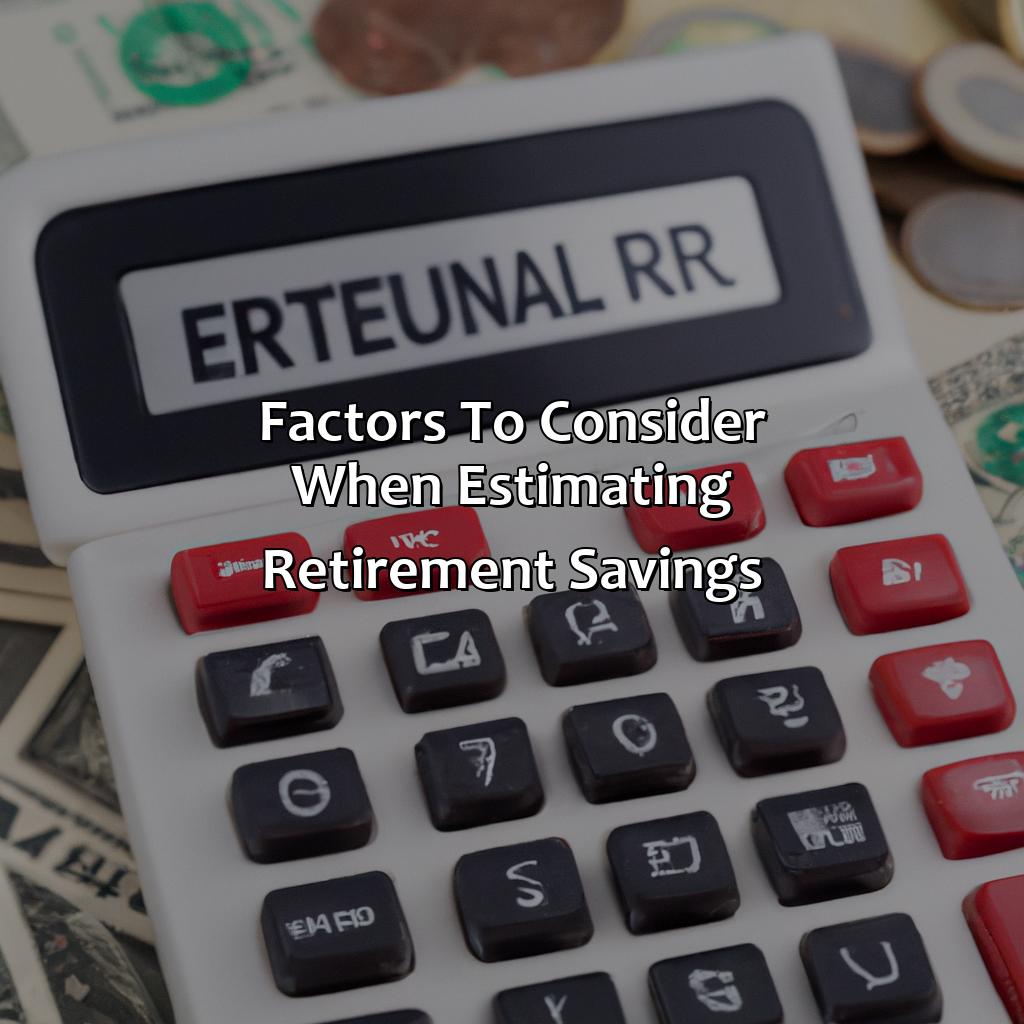How Much Should You Have In Retirement?
Key Takeaway:
\n
- It is recommended to have at least 25 times your annual expenses saved for retirement. This will ensure that you have enough money to last through your retirement years.
- Various factors such as age of retirement, retirement lifestyle and expenses, life expectancy, and inflation and cost-of-living increases must be considered when estimating your retirement savings amount.
- To save for retirement, it is important to start early and save consistently, maximize employer-sponsored retirement plans, invest wisely for growth and income, and revisit and adjust your retirement savings plan regularly to ensure you stay on track.
\n
\n
\n
Are you worried about retiring comfortably? You may be wondering how much you should have saved for retirement. This article will give you insight into the amount of money you’ll need to ensure you have a secure future.
How much should you have saved for retirement?
There is no one-size-fits-all answer to the question of how much one should have saved for retirement. Factors such as lifestyle, health, inflation, and life expectancy should be considered. A good rule of thumb is to have at least eight times your final salary saved by retirement.
To achieve this financial goal, it is crucial to start saving early and consistently. Investment options such as 401(k)s and IRAs are a great way to grow retirement savings. Employers may also offer matching contributions, which can increase retirement savings exponentially. One should also review and adjust their retirement plan periodically to ensure they are on track towards their goal.
Unique details to consider when planning for retirement include healthcare costs, potential future inflation rates, and potential changes to social security benefits. It is essential to factor in these potential expenses and changes to ensure a comfortable retirement.
Pro tip: Strive to save beyond the recommended amount to ensure a comfortable retirement and prepare for unexpected expenses.

Image credits: retiregenz.com by David Duncun
Factors to consider when estimating retirement savings
For a comfy retirement, you require to look at multiple factors. When do you want to retire? What’s the lifestyle you desire? How long will you live? Inflation & cost of living increases – all these must be considered. Let us discuss these elements in detail and plan for retirement.

Image credits: retiregenz.com by Yuval Woodhock
Age of retirement
When planning for retirement, one important factor to consider is the age at which you plan to stop working. The earlier you plan to retire, the more savings you will need to have accumulated. Alternatively, if you plan to work longer, you may be able to save less each year and still reach your retirement goals.
It’s crucial to keep in mind that your choice of retirement age will have a significant impact on the amount of money you need to save. If you decide on an early variation, you ineluctably require a bigger nest egg due to potential increased healthcare and living expenses from additional years of not actively earning an income. A late literal meaning also offers opportunities as it can delay Social Security and lead to higher monthly payouts.
In addition to saving enough money in preparation for retirement, it’s essential not only thinking about monetary assets but also intangibles such as hobbies and socializing with family & friends can reduce loneliness and depression at old age. Remember, a comfortable lifestyle throughout the retirement phases can help us live life in full swing.
Make sure not to delay planning for retirement. Long-term investment with fine-tuning your Semantic search results over time can aid in hitting your observed numbers by taking expert guidance from professionals who are experienced in this domain that helps minimizing financial-pitfalls.
Don’t worry, your retirement expenses won’t include impulse purchases from the snack aisle anymore.
Retirement lifestyle and expenses
When determining retirement finances, it is crucial to consider your desired post-retirement lifestyle and expenses. Expenses may include but are not limited to housing, healthcare, and leisure activities. Your retirement age, life expectancy, and inflation rates can also greatly impact your savings plan.
Paying careful attention to your desired level of security in retirement will help guide your saving strategy. Knowing precisely how much you need to save for a comfortable retirement is vital as inadequate financial planning could lead to regret later on.
It is essential to plan ahead so that you are not caught off guard by unexpected living or medical expenses that can arise in retirement. Consider seeking the advice of a qualified financial advisor who can provide insight into the unique factors that are most relevant to your circumstances.
Overall, prioritize saving early and consistently, so you don’t miss out on the opportunity for a stress-free financial future. Start now!
Retirement planning is like trying to predict your life expectancy – it’s a guessing game, but with higher stakes.
Life expectancy
Understanding the duration of life is a crucial factor when estimating retirement savings. With various factors such as medical advancement, lifestyle changes and genetics, the lifespan has significantly improved in recent years. It is important to consider one’s family history, living conditions and overall health to make an educated guess on life expectancy.
Moreover, a longer life expectancy also means more financial obligations like healthcare and other expenses. This must be kept in mind while setting up a retirement savings plan. One can use online calculators or seek professional help to estimate their longevity.
It is imperative to understand that even though life expectancy numbers may serve as guidance, they do not represent individual circumstances entirely. Other important factors include gender, income level, location and lifestyle choices.
During the 1800s, the average lifespan was only around 40 years old due to numerous illnesses. However, with the advancement in healthcare and developments in science and technology sectors by 2020, the average lifespan has increased to above 70 years old globally. This highlights that planning for post-retirement financial stability becomes increasingly crucial in modern times.
Retirement savings may seem like enough now, but with inflation, it’ll be worth less than that time you spent a fortune on Beanie Babies.
Inflation and cost of living increases
As the years go by, inflation continues to rise, leading to an increase in the cost of living. This circumstance has to be considered when estimating your retirement savings, as it will affect the purchasing power of your finances in the future.
Estimating retirement savings without considering inflation and cost-of-living increases will not provide an accurate picture of what you will need in retirement. You have to factor in how much income you expect to need per year and how much that amount would increase annually with inflation. Without taking this into account, your retirement savings may fall short.
Be mindful that some expenses may grow faster than others concerning inflation. Healthcare expenses tend to increase at a compounded rate exceeding actual CPI growth rates from many years.
According to Forbes magazine, 64% of Americans believe their healthcare costs could be their largest expense during retirement. These costs could impact their ability to travel or maintain a comfortable standard of living while preserving their nest egg for future generations.
Saving for retirement is like investing in yourself, except instead of dividends, you get to enjoy not working anymore.
Strategies for saving for retirement
To live comfortably in retirement, you need a plan! Here’s four sections to help:
- Start ASAP and save often
- Make the most of employer retirement plans
- Invest wisely for growth and income
- Check-in and adjust your plan regularly

Image credits: retiregenz.com by David Woodhock
Starting early and saving consistently
Saving systematically and initiating early retirement planning is crucial to secure a stress-free future. Here are some key considerations that can help you get started:
- Automate your savings: Use automatic payroll deductions and allow your employer to deposit a portion of your salary into your retirement savings account.
- Maximize contributions: As retirement saving plans have tax benefits, maximize them by increasing contribution rates to the maximum allowed limit.
- Investments and risks: Choosing investment strategies that align with your goals can optimize returns. Be mindful of market fluctuations but do not shy away from calculated risk-taking.
- Create a personalized plan: Every individual’s financial needs differ. Knowing the right amount you should have saved when retiring helps you set long-term goals and adjust accordingly.
To ensure that the retirement funding covers not only basic expenses but also provides lifestyle financial support, it’s important to consider aspects such as inflation and unexpected emergencies without undermining quality of life.
Pro Tip – Consider seeking professional guidance from financial experts as they can offer comprehensive insights on several options for optimized planning based on risk tolerance and expectations.
Maybe your employer-sponsored retirement plan is just their way of saying sorry for paying you so little now.
Maximizing employer-sponsored retirement plans
To enhance retirement plans, the utilization of employer-sponsored programs is crucial. The maximization of these plans involves the efficient allocation of funds and taking advantage of available tax benefits.
Employer-sponsored retirement programs are an effective way to increase financial security in old age. Contributions can be allocated based on risk tolerance, investment objectives, and company guidelines. With matching programs from employers, maximizing contributions can lead to significantly larger retirement savings.
The best plan is to invest as much as possible in a 401(k) or employer-sponsored plan that offers tax benefits. Consider if an Individual Retirement Account (IRA) could be beneficial for added savings, but always prioritize employer-sponsored options for maximum contribution potential.
Pro Tip: When maximizing your employer-sponsored retirement plans, identify which investment options are best suited to your financial goals and track progress regularly.
Your retirement plan should include investing wisely, because nothing says ‘golden years’ like a stock portfolio with more ups and downs than a rollercoaster.
Investing wisely for growth and income
One of the most critical steps in securing a comfortable retirement is investing smartly for wealth and income generation over time. It is crucial to balance both growth and income-oriented investments to achieve this goal effectively. Growth investments, such as stocks or ETFs, have the potential for maximum returns but are also riskier than bonds or certificates of deposit, which produce regular income streams. Income-focused assets provide steady revenue, but their returns may not keep pace with inflation.
To strike a competent balance between growth and income in retirement planning, one should incorporate different asset classes into their portfolio like dividend-paying funds, low-cost index funds, dividend aristocrats from various sectors like utilities, consumer goods, energy and healthcare. A wise investment strategy can help diversify risks across multiple instruments while capitalizing on higher returns from securities that offer comparatively more growth potential while keeping tax strategies in check.
People widely preferred investing in blue-chip stocks once upon a time for stable returns. Many companies like Kodak, Blockbuster looked untouchable at one point of time; investors had faith that these companies would continue to generate predictable returns year after year; however, the companies began losing ground to younger competitors who took advantage of newer technologies or shifts in consumer preferences.
Investing wisely for retirement is key; it is essential to balance both growth & income-oriented investments effectively – Dividends, Low-Cost Index Funds & Aristocrats with diverse sectors/divisions. While many firms look promising, it’s vital to keep an eye on emerging innovations in today’s ever-changing world & shift to new sectors if necessary.
Revisiting and adjusting retirement savings plan regularly
It is essential to continuously evaluate and modify your retirement savings plan to align with changing circumstances. Regularly reassessing your retirement financial strategy allows you to ensure that it aligns with your current investment goals, risk tolerance, and timelines.
Proactive reviews of your investment vehicles such as mutual funds, stocks, bonds, and annuities can help an investor make necessary shifts that support their long-term saving efforts. By staying up-to-date with dynamic economic conditions and financial market fluctuations through regular monitoring of portfolios, adjustments can be made promptly and adequately.
Moreover, taking advantage of professional consultations when revisiting a retirement saving plan is beneficial. Consulting a financial adviser or planner to provide expert guidance helps promote self-awareness while increasing the likelihood of reaching one’s goals.
History shows that many retirements have lasted longer than anticipated; for instance, life expectancy has increased over recent years past the traditional retirement age. Adjusting plans in response to longer periods in retirement prevents depletion of savings too soon after retiring. Moreover, it helps ensure retirees sustain an adequate quality of life throughout this period.
Some Facts About How Much You Should Have in Retirement:
Experts recommend saving at least 10-15% of your income for retirement. (Source: CNBC)
The average American will need 70-90% of their pre-retirement income to maintain their lifestyle in retirement. (Source: U.S. News)
The average 401(k) balance for Americans in their 60s is $195,500. (Source: Vanguard)
Retirement expenses can vary based on factors such as healthcare costs, housing expenses, and travel plans. (Source: Investopedia)
Financial advisors suggest having a plan in place to manage retirement income and investments to ensure a comfortable retirement. (Source: Forbes)
FAQs about How Much Should You Have In Retirement?
How much should you have in retirement?
It’s recommended to have around 10-12 times your current annual income saved for retirement.
Is there a specific age where I should start saving for retirement?
It’s never too early to start saving for retirement, but the ideal time to start is in your 20s.
What percentage of my income should I save for retirement?
Aim to save at least 15% of your income for retirement, but if you’re starting late, you may need to save even more.
What factors should I consider when determining how much to save for retirement?
Your desired retirement lifestyle, expected expenses, inflation, and potential healthcare costs should all be considered.
What if I haven’t saved enough for retirement?
It’s never too late to start saving, even if it means making lifestyle adjustments to save more. Consider consulting with a financial advisor to help create a plan.
What are some retirement planning mistakes to avoid?
Avoid procrastinating, underestimating expenses, not diversifying investments, and withdrawing from retirement accounts too early.
 Checkout this IRS Loophole
Checkout this IRS Loophole 






